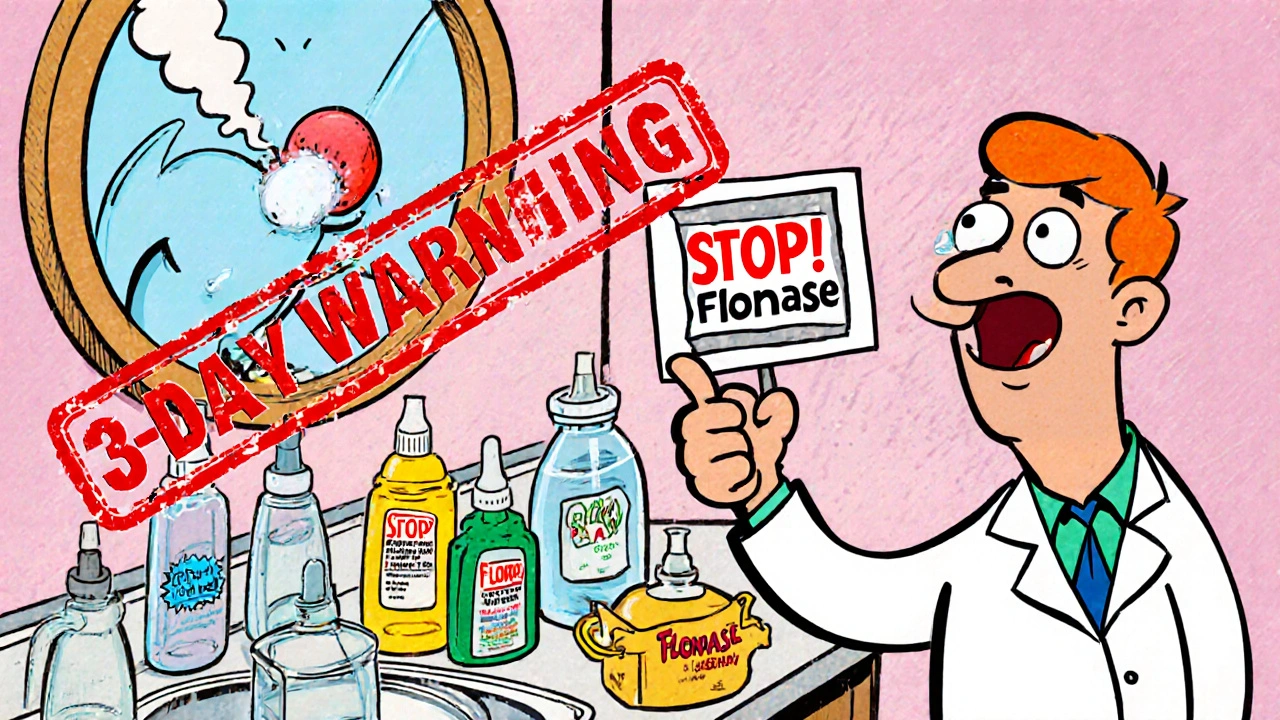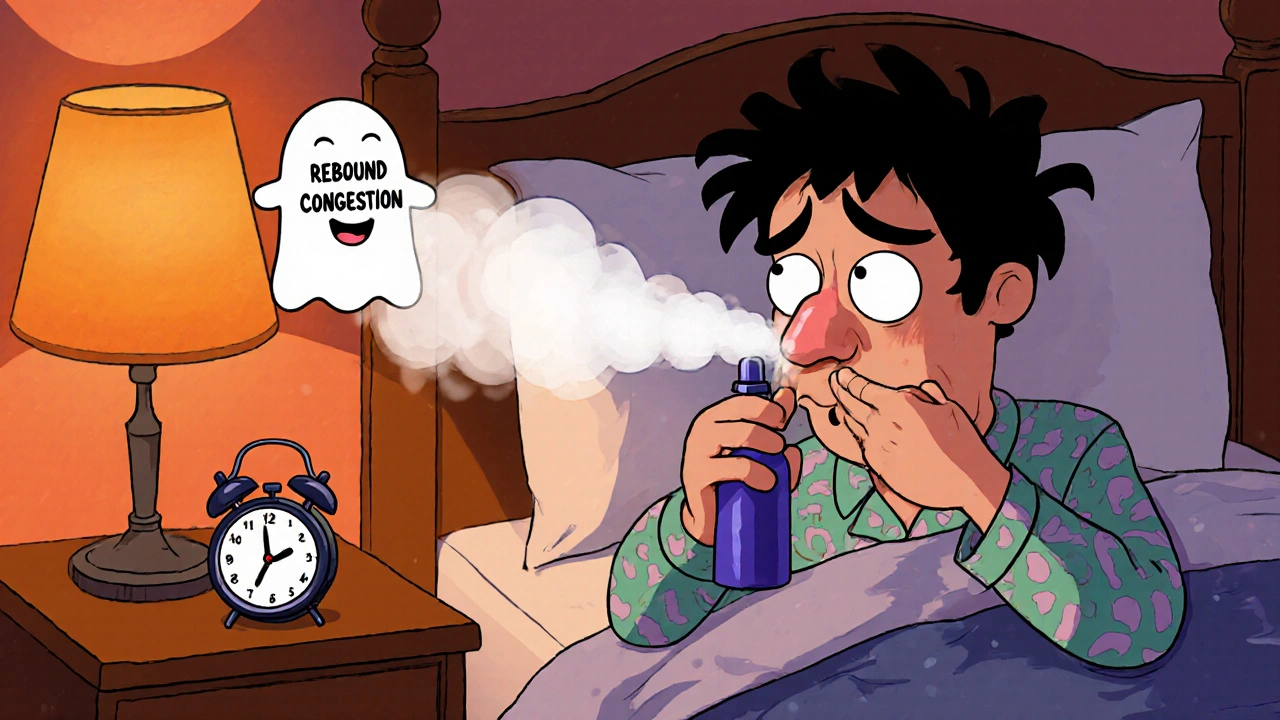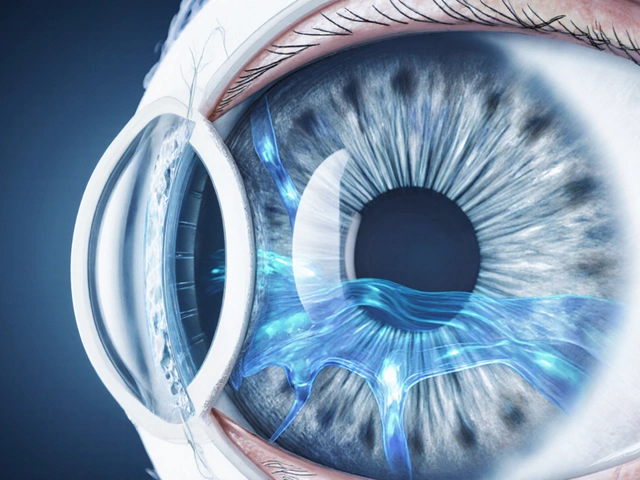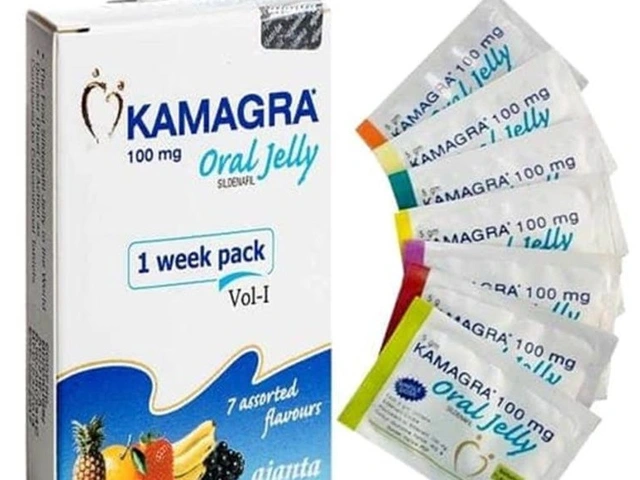Rebound Congestion Recovery Calculator
Estimate your recovery timeline based on how long you've been using nasal decongestant sprays. This tool helps you understand your healing process and set realistic expectations.
Ever used a nasal spray for a stuffy nose, only to find yourself needing it more and more-until you can’t breathe without it? You’re not alone. This isn’t just a bad habit. It’s a real medical condition called rhinitis medicamentosa, or rebound congestion. And it’s more common than most people realize.
How Your Nasal Spray Is Making Things Worse
Nasal decongestant sprays like Afrin, Neo-Synephrine, and Otrivin work fast. They shrink swollen blood vessels in your nose, giving you instant relief. But that relief is temporary. After a few hours, the vessels open up again-sometimes even wider than before. That’s called rebound vasodilation. And if you keep spraying, your nose gets used to it. Soon, you need more spray, more often, just to feel normal.The science is clear: using these sprays for more than three to four days in a row triggers this cycle. According to the Mayo Clinic, over 90% of people who use them past a week end up with worse congestion than when they started. The NHS warns that using them for more than a week can permanently damage the lining of your nose. And it’s not just sprays-oral decongestants like pseudoephedrine can also cause problems, especially if you have high blood pressure.
What does it look like in real life? You wake up with a blocked nose. You spray. You feel better for a few hours. Then it’s back. You spray again. By day five, you’re spraying every three hours. By day ten, you’re breathing through your mouth, your throat is dry, and you’re snoring all night. You think it’s a cold that won’t go away. But it’s the medicine itself.
What Rhinitis Medicamentosa Really Looks Like
This isn’t just a stuffy nose. It’s a physical change in your nasal tissues. Doctors see it clearly during exams: the inside of the nose becomes swollen, red, and grainy. In advanced cases, the lining turns pale, thin, and crusty. Some people develop nasal polyps-small, noncancerous growths-that can block airflow even after they stop the spray.Patients often report:
- Constant congestion, even without a cold or allergies
- No runny nose-just pure blockage
- Difficulty sleeping due to mouth breathing
- Dry mouth, sore throat, and bad breath
- Feeling like you’re suffocating at night
It’s not just uncomfortable-it’s exhausting. One Reddit user, who went through this in 2023, wrote: “I cried because I couldn’t breathe. I didn’t sleep for four nights straight. I felt like my nose had betrayed me.” That’s not an exaggeration. This condition affects sleep, mood, focus, and even your ability to exercise.
The Only Way to Fix It: Stop the Spray
Here’s the hard truth: the only cure for rebound congestion is to stop using the decongestant spray entirely. There’s no shortcut. No magic pill. No way around it.But stopping cold turkey can feel unbearable. That’s why doctors don’t just say “quit”-they give you a plan.
The Mayo Clinic recommends a smart approach: stop the spray in one nostril first. Wait until that side clears up (usually 3-5 days), then stop it in the other. This way, you’re still breathing through one side while the other heals. Many patients find this method far more manageable than stopping both at once.
The Cleveland Clinic, however, suggests a slower taper: reduce your spray use by half every two days until you’re off it completely. Both methods work. The key is consistency. Don’t go back to the spray, even for one puff. That one puff can reset the whole cycle.

What to Use Instead: Proven Alternatives
While your nose heals, you need relief. And there are safe, effective options that won’t trap you in the same cycle.Intranasal corticosteroids are the gold standard. Sprays like Flonase (fluticasone) and Nasonex (mometasone) reduce inflammation without causing rebound. They take a few days to work, but studies show 68-75% of patients see major improvement within two weeks. Use them twice daily at first, then once daily as your nose improves. Don’t stop too soon-give them at least two full weeks.
Saline nasal irrigation is another powerful tool. Using a neti pot or squeeze bottle with sterile saltwater flushes out irritants and keeps your nasal passages moist. A 2022 review found it helped 60% of patients during withdrawal. Do it twice a day-morning and night. It’s free, safe, and works even when nothing else does.
Oral corticosteroids like prednisone are used in severe cases. A five-day course (0.5 mg per kg of body weight) can break the cycle fast. But this is only for short-term use under a doctor’s care. It’s not for everyday relief.
Some newer options are showing promise. Azelastine nasal spray (an antihistamine) and low-dose capsaicin sprays (from chili peppers) are being tested in clinics. Early results suggest they reduce congestion in 65-70% of users, without the rebound risk. These aren’t widely available yet, but they’re coming.
Why Most People Fail-And How to Succeed
The biggest reason people go back to the spray? They’re not prepared for the withdrawal.Days 1-3 are the worst. Congestion peaks. You feel like you’re suffocating. Sleep is impossible. That’s when most people give up.
But here’s what works:
- Plan ahead. Tell yourself: “I’m doing this for two weeks. I’ll feel better after.”
- Use saline irrigation every 2-3 hours during the first 72 hours.
- Start your corticosteroid spray on day one-even if you don’t feel better yet.
- Keep your room humid. A cool-mist humidifier helps a lot.
- Drink plenty of water. Dehydration makes congestion worse.
- Don’t use any other decongestants, even oral ones like pseudoephedrine.
Success rates jump from 40% to over 80% when people follow this plan. One study found that patients who got counseling before quitting were 3 times less likely to relapse.

How to Prevent This From Happening Again
Once you’re better, don’t go back to the same trap.Here’s what the FDA, Mayo Clinic, and American College of Allergy all agree on:
- Never use decongestant sprays for more than 3 days.
- Always read the label. The warning is there for a reason.
- If your nose is still stuffy after 3 days, see a doctor-not the pharmacy.
- Use saline irrigation first. It’s the safest starting point.
- If you have allergies, try antihistamines or corticosteroid sprays instead.
Since late 2022, U.S. law requires all OTC nasal sprays to have a bold “DO NOT USE MORE THAN 3 DAYS” warning on the packaging. But most people still miss it. Don’t be one of them.
When to See a Doctor
You don’t need to suffer alone. See a doctor if:- You’ve been using the spray for more than a week
- Your congestion hasn’t improved after 2 weeks of stopping
- You’re having trouble sleeping, eating, or breathing
- You notice bleeding, crusting, or a foul smell from your nose
- You have high blood pressure, heart disease, or thyroid problems
A specialist can check for polyps, chronic sinusitis, or other issues hiding behind the congestion. They can also prescribe stronger treatments if needed.
This isn’t weakness. It’s smart health.
Can nasal decongestant sprays cause permanent damage?
Yes, long-term overuse can cause lasting changes to your nasal lining. The tissue can become thin, dry, and crusty. In some cases, it leads to nasal polyps or even a condition called atrophic rhinitis, where the inside of the nose shrinks and loses its ability to function normally. The good news? If you stop early-within a few weeks-your nose can often heal completely. The longer you wait, the harder it gets.
Is it safe to use saline spray every day?
Absolutely. Saline nasal irrigation is safe for daily use, even long-term. It doesn’t cause rebound congestion, doesn’t interact with other medications, and helps keep your nasal passages moist and clean. Many people use it every morning as part of their routine, especially if they live in dry climates or have allergies. Just make sure to use distilled, sterile, or previously boiled water to avoid infection.
Why does my nose feel worse when I stop the spray?
That’s rebound congestion in action. Your nasal blood vessels got used to being constricted by the spray. When you stop, they overcompensate by swelling up even more than before. It’s like a rubber band snapping back too far. This usually peaks around days 2-4 and starts improving after day 5. It’s temporary, but it’s intense. That’s why having a plan-like saline rinses and corticosteroid sprays-is critical.
Can I use oral decongestants like pseudoephedrine instead?
Not as a long-term replacement. Oral decongestants like pseudoephedrine work similarly to nasal sprays-they constrict blood vessels. They can raise your blood pressure, increase your heart rate, and cause anxiety or insomnia. They’re okay for occasional short-term use, but they don’t solve the root problem. And if you’re already dependent on nasal sprays, switching to pills won’t help you break the cycle. Stick to saline and corticosteroids instead.
How long does it take to recover from rebound congestion?
Most people start feeling better after 5-7 days, with major improvement by day 14. Full recovery can take up to 4 weeks, especially if you’ve been using the spray for months or years. The key is patience and consistency. Don’t rush. If you’re still blocked after 4 weeks of stopping the spray and using corticosteroids, see an ENT specialist. You might need further testing for other causes like chronic sinusitis or structural issues.







shreyas yashas
November 23, 2025 AT 01:35I used to be addicted to Afrin for years. I didn’t even realize it until I couldn’t sleep without spraying every two hours. One night I woke up choking on my own mucus-no joke. Started saline rinses, cut back slow, and now I’m three months clean. My nose actually feels normal again. It’s not easy, but it’s worth it.
Jennifer Shannon
November 23, 2025 AT 13:45There’s something deeply poetic about how our bodies rebel when we try to shortcut nature, isn’t there? We reach for the quick fix-spray, breathe, feel alive-and forget that the body is a system, not a switch. The nose doesn’t hate you; it’s just trying to restore balance after being manipulated. The real tragedy isn’t the congestion-it’s how normalized dependency has become. We’ve turned medicine into a crutch, and then blamed ourselves for needing it. But healing? Healing is slow, quiet, and requires patience. And maybe that’s the lesson we were never taught.
Bryson Carroll
November 25, 2025 AT 06:28Wow this is such a basic article. Everyone knows you can't use nasal sprays long term. Why are we even talking about this like it's new news? It's like writing a 2000 word essay on why you shouldn't drink bleach. The real issue is people who don't read labels. That's not a medical problem, that's a literacy problem.
Lisa Lee
November 26, 2025 AT 05:43Ugh I hate how Americans turn everything into a wellness cult. Just stop being lazy. If you can’t breathe, go to a doctor. Don’t waste time with neti pots and ‘corticosteroids’ like it’s some spiritual cleanse. Just take a pill like a normal person. We’re not in a yoga retreat here.
Richard Wöhrl
November 28, 2025 AT 05:15Important note: The ‘one nostril at a time’ method works, but only if you’re disciplined. I tried it once and switched back after 36 hours because I panicked. The withdrawal is brutal-headaches, anxiety, even dizziness. But here’s what helped: I used a humidifier, drank 3L of water daily, and applied a thin layer of petroleum jelly inside my nostrils to reduce cracking. Also, sleep with your head elevated. It’s not glamorous, but it’s science.
Manjistha Roy
November 28, 2025 AT 21:11My mother had this for 12 years. She didn’t believe it was the spray until her ENT showed her the tissue under the scope-it looked like burnt paper. She cried. Then she did the full 6-week plan: saline twice a day, Flonase, no exceptions. Now she uses saline only. No sprays. No regrets. If you’re reading this and you’re stuck-please, don’t wait like she did. Start today.
Suzan Wanjiru
November 29, 2025 AT 17:57Saline irrigation is underrated. I use it every morning after showering. It’s like a reset button for your sinuses. And yes, you can do it with a squeeze bottle-no neti pot needed. Just make sure the water is distilled or boiled and cooled. Tap water is a no-go. I’ve seen too many people get rare fungal infections because they used faucet water. Don’t be that person.
Olanrewaju Jeph
December 1, 2025 AT 07:31Let me clarify: pseudoephedrine is not a safe alternative. It is a vasoconstrictor, yes, but it affects systemic circulation. In individuals with hypertension, it can trigger arrhythmias or stroke. The FDA has restricted its sale precisely because of these risks. If you are dependent on nasal decongestants, oral alternatives only delay the inevitable. The only sustainable solution is cessation and anti-inflammatory management. This is not opinion. This is clinical fact.
Henrik Stacke
December 1, 2025 AT 15:51Oh my goodness, this post brought back memories. I remember lying on the bathroom floor at 3 a.m., gasping, convinced I was dying. I had been using Otrivin for 11 days straight. I didn’t know what was happening. My wife found me like that. She made me stop. I was furious. But she didn’t give in. She bought me saline spray, a humidifier, and sat with me while I cried through the first three nights. It took 17 days to feel normal. But I’m here. And I’ll never touch that spray again. Thank you for writing this. It’s not just medical advice-it’s a lifeline.
Jennifer Skolney
December 1, 2025 AT 19:20I went through this last year. It was the worst thing ever. I cried every night. But I started using Flonase on day one and saline every 3 hours. I also started drinking bone broth. Yes, really. It helped with the inflammation. And I used a cold compress on my face. It didn’t fix everything, but it made the pain bearable. I’m 6 months clean now. You can do this. 💪
JD Mette
December 2, 2025 AT 03:34I appreciate the thorough breakdown. I’ve seen patients in my clinic struggle with this for years. Most don’t realize it’s not a cold or allergies. They think they’re ‘just congested.’ It’s heartbreaking. The key is education-before the addiction starts. Maybe pharmacies should offer a 2-minute video when you buy these sprays. Just a heads-up. Not a lecture. Just: ‘This can backfire. Here’s how to avoid it.’ Simple.
Dalton Adams
December 3, 2025 AT 21:34Look I’ve read every study on this. You’re all missing the real issue: the pharmaceutical industry doesn’t want you to know that saline works better than their $30 spray. They profit from your addiction. Flonase? That’s a billion-dollar drug. Saline? Costs 5 bucks. Coincidence? I don’t think so. The FDA lets them slap on a tiny warning because they’re paid off. Wake up. This isn’t medicine-it’s capitalism.
Kane Ren
December 5, 2025 AT 13:46It’s possible to beat this. I did. It’s not about willpower. It’s about replacing the habit. I swapped the spray for a neti pot and a humidifier. I didn’t think I could survive the first week. But I did. And now I feel like I’ve been given back my life. You’re not broken. You’re just caught in a trap. And traps can be escaped.
Charmaine Barcelon
December 6, 2025 AT 02:28Stop using this stuff. That’s it. No excuses. You’re weak if you can’t quit. My cousin did it in 3 days. No neti pots. No flonase. Just stopped. Now she breathes fine. You’re making it harder than it is. Just quit.
Kezia Katherine Lewis
December 6, 2025 AT 14:54From a clinical perspective, the pathophysiology of rhinitis medicamentosa involves downregulation of alpha-adrenergic receptors in the nasal mucosa, leading to paradoxical vasodilation upon withdrawal. The therapeutic window for corticosteroids is optimal when initiated within 24–48 hours of cessation, as they modulate IL-4, IL-5, and eosinophilic inflammation. Saline irrigation reduces mucosal viscosity and enhances ciliary clearance. A multimodal approach-pharmacologic and mechanical-is superior to monotherapy. This is not anecdotal; it’s evidence-based.